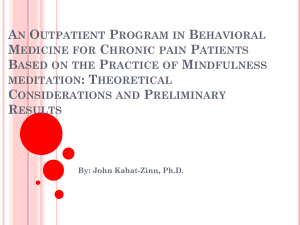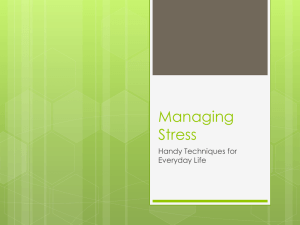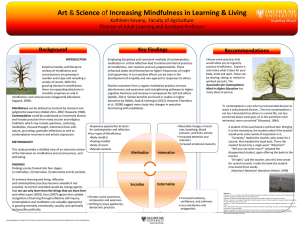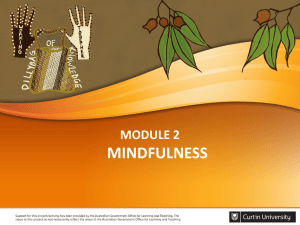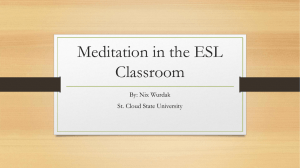Using Mindfulness for people with Enduring Needs
advertisement
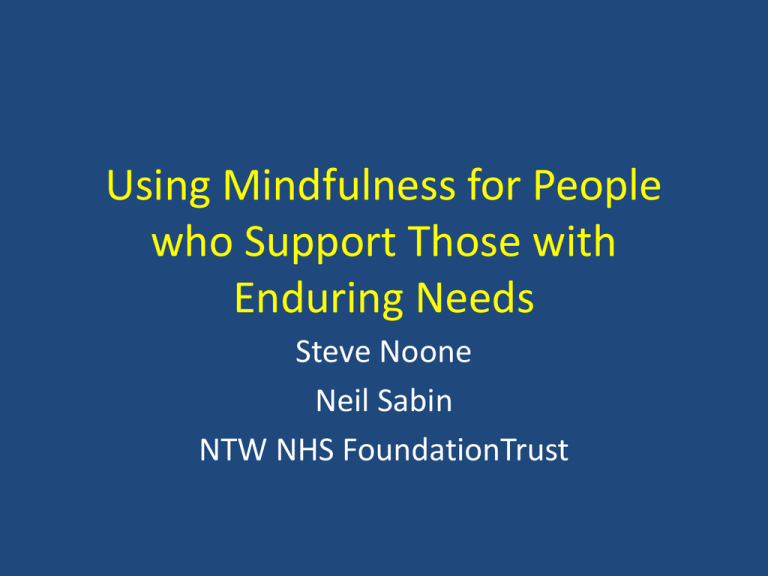
Using Mindfulness for People who Support Those with Enduring Needs Steve Noone Neil Sabin NTW NHS FoundationTrust Over view • Discovering the wolf…. Over view • How should we ‘prepare’ staff for what they may experience whilst caring ? • Provide a conceptual overview • Consider some simple exercises • Time to share ideas Staff Behaviour Challenging Behaviour Staff Negative Emotional Reactions Staff Behaviour Challenging Behaviour Staff Stress Staff Negative Emotional Reactions Staff Behaviour Challenging Behaviour Staff Stress Staff Negative Emotional Reactions Staff Behaviour Challenging Behaviour Staff Stress Staff Negative Emotional Reactions Staff Behaviour Challenging Behaviour Feelings identified by carers (R McDonald 2006) • Good: Trusted, worthwhile, skilled, connection, empathy, happiness, satisfaction, joy, excitement, pride, relief, heart-warming Feelings identified by carers (R McDonald 2006) • Uncomfortable: Embarrassment, stupidity, anxiety/fear, confusion, anger, sadness, failure, overwhelmed / dread, useless, frustration, disbelief, alarming and nerve-wracking, distressed, powerless, annoyed, shame at own disgust Becoming a Resilient Caregiver McCurry (2006) • Resigned - asks for no help often becomes sick and depressed • Resentful - shocked and bitter will often blame others • Resilient - detach themselves and not take the behaviour personally Becoming a Resilient Caregiver • Resilient - detach themselves and not take the behaviour personally • Maintain a sense of humour • Aware of the tender moments in the day and look for the uplifts that are part of being a caregiver Research • Acceptance and Commitment Therapy – Occupational Stress (Bond & Bunce, 2000; Bond & Flaxman, 2006; Bond, Flaxman, & Bunce, 2008) – (Noone & Hastings; 2009; 2010; 2011). • Mindfulness and field learning disabilities – care staff working with aggression, (Singh et al., 2006), – reduce the use of physical restraint, (Singh et al., 2009) with forensic services, (Singh et al., 2011) – with patients with aggression and mental health problems (Singh, et al.,2007) and clients with learning disabilities and aggression, (Singh, Wahler, Adkins & Meyers, 2003). What is ACT ? • Psychotherapeutic approach built on principles of behavioural analysis • Normalises human suffering • Much of suffering is a consequence of – verbal evaluation of an event and – attempt to avoid ones experience Core Ideas of ACT • Clean pain: falling down a hole • Dirty pain: is trying to dig • What happens if attempting to control is the problem? Core Ideas of ACT • To try and control is to try and stop experiencing what you are experiencing • Leads to experiential avoidance • The real problem is lack of psychological flexibility The transcendent challenge of our time is the objectification and dehumanization of others Steve Hayes Consider these photos • Just look at each photo and notice what thoughts pop into your head • They will be either neutral • Positive • ….or negative Past and Future Unclear values Experiential Avoidance Psychological Inflexibility Inaction Fusion Conceptualized Self (Ego) Contact with the present moment Values Acceptance Promoting Psychological Flexibility Committed Defusion Action Self as Context Where to start ? Structure of Day • Reflection – on what I bring to my job – personal cost of being stressed – how thoughts operate • Clarify – my values and how I want to live my life • Discriminate – coping that works and what doesn’t – between me and my thoughts • Make a personal commitment to my values What do you bring to your job • • • • • • • • Patience Humour Stay calm Keep to care plan Listen Empathy Understanding Share good times • • • • • • • Protect rights Enable development Ensure safety Protect dignity Advocate for person Energy Enthusiastic Relentless Questioning Throwing Objects One client attacking another client Attacked with Objects Head Banging with fist Air Swallowing Withdrawing Scratching Biting Banging head against wall Spitting Kicking Picking own wounds Hand Biting Breaking Furniture Punching Screaming Eye Gouging Running away Job Advert • Wanted: • Patient, calm, understanding, empathic, energetic, enthusiastic person, who is able to keep to care plan, protect the rights of a vulnerable person, ensure the safety of clients and members of the public,will protect the dignity of stigmatised people and be a keen advocate. Job Advert • To work with people who will: • Bite, throw objects, scratch, attack you with objects,head bang with fist, withdraw, bang head against wall, spit, bite their own hand, run away, break furniture, attack other clients, kick,eye gouge, scream, ask continuous questions, pick own wounds, swallow air, Job advert • A good sense of humour and a clean driving license desirable. • The organisation is committed to promoting a work -life balance Structure of Day • Reflection – on what I bring to my job – personal cost of being stressed – how thoughts operate • Clarify – my values and how I want to live my life • Discriminate – coping that works and what doesn’t – between me and my thoughts • Make a personal commitment to my values Clarifying Values THE SWEET SPOT Vividly recall a “sweet “memory and get in touch with the emotions. What is meaningful about this memory? WHAT MATTERS? What do you really want? What matters to you, in the big picture? What do you want to stand for? Is there anything in your life right now that gives you a sense of meaning, purpose, vitality? SPEECHES Imagine your 80thbirthday (or 21stor 50th, or retirement party etc). 3 people make speeches about what you stand for, what you mean to them, the role you played in their life. Imagine them saying whatever you most want to hear. FORMS & WORKSHEETS Valued living questionnaire Bull’s eye Life compass Structure of Day • Reflection – on what I bring to my job – personal cost of being stressed – how thoughts operate • Clarify – my values and how I want to live my life • Discriminate – coping that works and what doesn’t – between me and my thoughts • Make a personal commitment to my values Past and Future Unclear values Experiential Avoidance Psychological Rigidity FUSION Entanglement with categorical, judgmental thought Inaction Conceptualized Self (Ego) Cognitive Defusion “I used to think that the brain was the most wonderful organ in my body. Then I realized what was telling me this.” -Emo Phillips Defusion exercises • Don’t think about chocolate cake! Forget the numbers • Objectify the mind – its only looking out for you • Leaves on a stream/ protestors/ cars in street • Replace “buts” with “ands” Past and Future Unclear values Experiential Avoidance Psychological Rigidity Inaction Fusion We buy into stories of who we are and who others are RFT & The Self The Three Selves Verbal behavior gives rise to three types of self: – Object of verbal knowledge • The conceptualized self • Self as content – Process of verbal knowledge • The knowing self • Self as process – Locus of verbal knowledge • transcendent self • Self as context or perspective Structure of Day • Reflection – on what I bring to my job – personal cost of being stressed – how thoughts operate • Discriminate – coping that works and what doesn’t – between me and my thoughts • Clarify – my values and how I want to live my life • Make a personal commitment to my values Values Assessment Rating Form Goals Actions & Barriers Using mindfulness with care staff 1. General Introduction to Mindfulness Staff Training a. Discussion of staff-individuals with (ID) positive and negative interactions b. Discussion of previous training programs t c. Staff members’ experiences with previous staff training d. Discussion of staff members’ expected outcomes e. Discussion of the aims of the mindfulness staff training f. Review of program requirements: reading, meditation practice, application of mindfulness, and data collection g. Maintaining a practice journal h. Set homework tasks 2. Knowing Your Mind a. Interactive review of homework b. Review of mindfulness and mindlessness c. Identification of instances of mindfulness and mindlessness during staff-individual with ID interaction d. Basic meditation techniques for sitting and walking meditation e. Meditation practice on Observing Your Mind f. Discussion of practice on Observing Your Mind and its applications in staff-individual with ID interactions g. Set homework practice 3. Focused attention a. Interactive review of homework b. Review of focused attention c. Breathing as focused attention or awareness d. Meditation practice on Breathing e. Discussion of practice on Breathing and its applications in staff-individual 4. Focused Attention on Arousal States a. Interactive review of homework b. Review of arousal states that precede and follow staff-individual with ID interactions c. Meditation practice on Arousal d. Discussion of practice on Arousal and its applications in staff-individual with ID interactions e. Set homework tasks 5. Being in the Present Moment a. Interactive review of homework b. Review of being in the present moment in the midst of chaos c. Meditation practice on Being in the Present Moment d. Discussion of practice on Being in the Present Moment and its applications in staff-individual with ID interactions e. Set homework practice 6. Beginner’s Mind a. Interactive review of homework b. Review of premature cognitive commitment; bounded versus unbounded reality; conditioned versus unconditioned responses c. Meditation practice on Beginner’s Mind d. Discussion of practice on Beginner’s Mind and its applications in staff-individual with ID interactions e. Set homework practice 7. Being One with the Individual with ID a. Interactive review of homework b. Review of being in the ‘zone’ or having a ‘peak experience;’ being one with the individual with ID c. Meditation practice on Being One with the Individual d. Discussion of practice on Being One with the Individual and its applications in staff-individual with ID interactions e. Set homework practice 8. Non-judgmental Acceptance a. Interactive review of homework b. Review of acceptance and non-judging; nonjudgmental acceptance of the individual with ID c. Meditation practice on Non-judgmental Acceptance d. Discussion of practice on Non-judgmental Acceptance and its applications in staff-individual with ID interactions e. Set homework practice 9. Letting go a. Interactive review of homework b. Review of doing one’s part and letting go of everything else c. Meditation practice on Letting Go d. Discussion of practice on Letting Go and its applications in staff-individual with ID interactions e. Set homework practice 10. Loving kindness a. Interactive review of homework b. Review of acting with loving kindness and compassion c. Meditation practice on Loving Kindness d. Discussion of practice on Loving Kindness and its applications in staff-individual with ID interactions e. Set homework practice 11. Problem Solving a. Interactive review of homework b. Review the nature of problems and solutions c. Meditation practice on Problem Solving d. Discussion of practice on Problem Solving and its applications in staff-individual with ID interactions e. Set homework practice 12. Using Mindfulness in Daily Interactions a. Interactive review of homework; data collection b. Putting it all together; review of meditation exercises and applications c. Meeting staff members’ expectations; staff-individual with ID interactions then versus now d. Discussion on mindfulness in daily interactions e. Plans for follow-up, keeping in touch, and long-term practice

